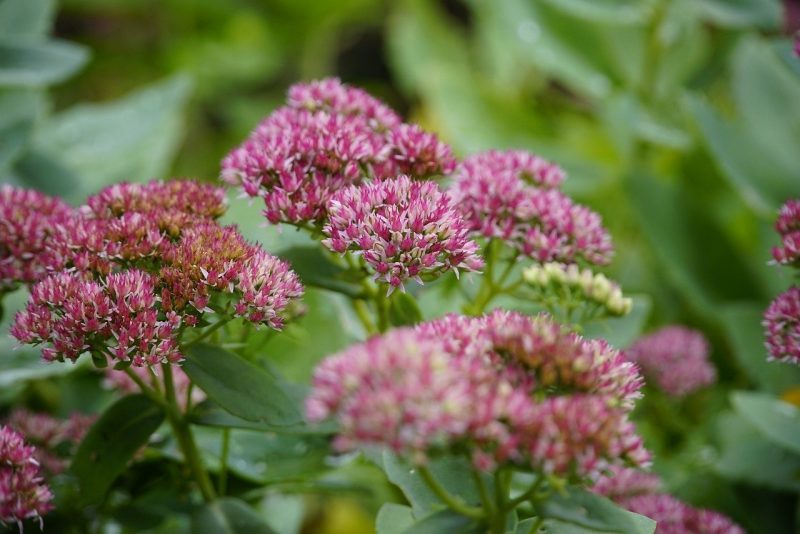Those who are interested to learn how to propagate sedum have three methods to choose from. Knowing how to grow sedum will put you at an advantage among other gardeners because you are not limited with how to reproduce them. More so, don’t feel overwhelmed in starting sedum because this plant is generally easy to grow and maintain.
While plants like sedum don’t easily struggle, remember that propagating plants must be in stable conditions. You can start sedums in the greenhouse until they are large enough for transplanting. This way, you can ensure that they will develop vigorously for transplanting.

How To Grow Sedum
Method #1. Seeds
Did you know that you can start sedum plants from seeds? It might not be the most common way to start sedum, but it’s also an excellent skill to know how to grow sedum seeds. While this technique takes longer and requires more labor, you can always use the seeds from your own plants, making your garden more productive.
Step #1. Sowing
The best time to start sedum seeds is four weeks before the last frost of spring. Much like with other plant seeds, it’s advantageous to grow your seeds in the greenhouse to encourage germination. The conditions are stable compared to the garden outside, so you can guarantee the seeds to develop.
Use a pot with drainage holes and fill with a moist starting mix as your medium. Sow the sedum seeds thinly on the surface with a space of an inch among them before covering them with the medium once more. Afterward, mist the container’s surface and cover it with clear plastic to maintain a humid environment suitable for germination.
Step #2. Maintenance
Choose a bright and warm area in the greenhouse for your seeds around 65 to 72°F as maintenance until they germinate. Always check your medium as well, as it shouldn’t be dry nor soggy. After your seeds sprout within two to four weeks, remove the cover and grow the seedlings under lights.
Method #2. Cuttings
The more straightforward method of propagating sedums is by cuttings. Using a cutting is a more guaranteed way of getting your sedum species’ copies than starting these plants from seeds. This is excellent if you want to predict the resulting characteristics of your new plants.
Stem cuttings
You have the option of using a cutting from the tip of the plant. Choose a healthy mature sedum and cut off a 6-inch section at the tip for rooting. Simply plant the stem cuttings in a tray with moist sand, but make sure to remove the lower leaves as they may rot.
You can expect the sedum tip cuttings to develop roots after two weeks. Gently tug the plant to indicate rooting, and then consider if you want to keep them in the greenhouse or outdoors to receive at least six hours of sunlight. Regardless, maintain soil moisture and keep your plants from extreme temperatures to help them establish themselves.
Leaf cuttings
Besides stem cuttings, sedums can also start from leaf cuttings. Select and cut off healthy leaves with a sharp and sterile knife. Make sure that they still have some stem on them to make it easier to root them.
You can also dip these cuttings in rooting hormone before planting in a container with moist potting soil. Cover the pots with plastic to conserve moisture, similar to growing sedum from seeds. Experienced gardeners even recommend using a heating pad to encourage growth faster.
Method #3. Division
The final method for propagating method is by division. You can also use division as an opportunity to transplant and maintain your sedum plants and keep your area looking tidier. The best time to do so is in spring, but the climate should not be too hot to avoid stressing the divisions.
Step #1. Digging
Dig around a mature plant to make it easier to lift the sedum off the ground. This way, you don’t risk damaging its root system. A useful technique is cutting through the ground with the shovel to keep the root ball intact.
Step #2. Replanting
Divide the root ball into several sections, ensuring that each piece has enough buds to develop. The divisions should also have many roots to make establishment easier. Once you have the divisions, replant them onto the same moist medium as they were at the same depth.
Do You Need To Prune Sedum?
While it’s not mandatory, you can maintain the plants’ shape and spacing by cutting them back. However, you can choose not to deadhead sedums after the blooming period for added aesthetics in winter. This will also open an opportunity to develop seed heads for propagation later on.
Conclusion
Sedum plants are one of the best succulent perennials to grow. You even have three methods to choose from if you want to know how to propagate sedum. And if you have a greenhouse, you can quickly encourage root development and establishment for quicker transplanting.
You can start sedum from seeds, but those who want to preserve specific plant characteristics can root from stem cuttings or leaf cuttings. On the other hand, sedum plants can also start from divisions if you want to transplant some overcrowded mature plants. Regardless of the method, ensure soil moisture and stable temperatures to help your sedums thrive.

I was given a sedum in a pot last fall. It came back and bloomed pink and now is more rusty color. It is October 5th. Can i sent stems to replant with flower still on. When I got it in the fall it looked dead {cut to soil in pot] So do I cut all it back to bottom of stems